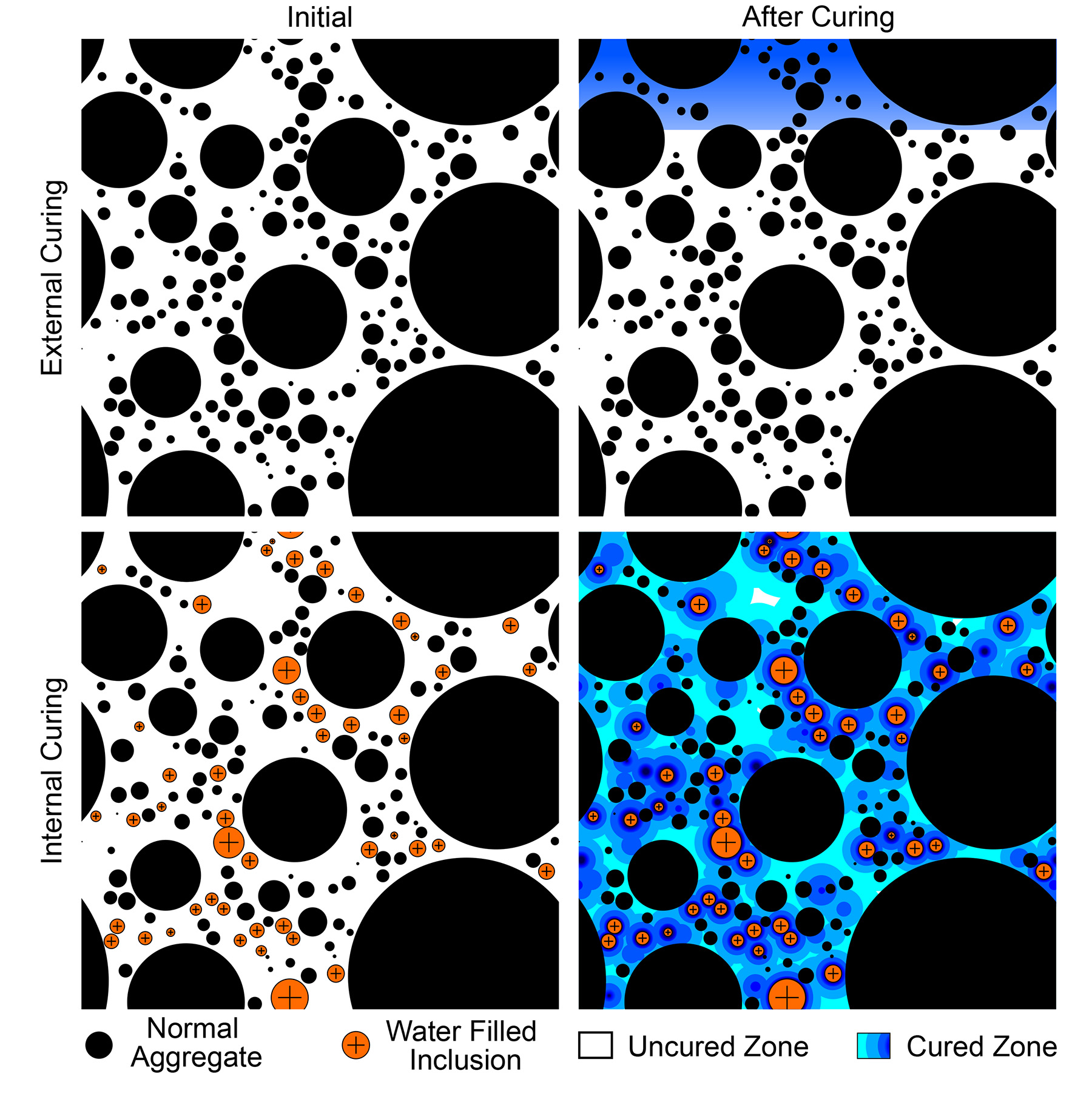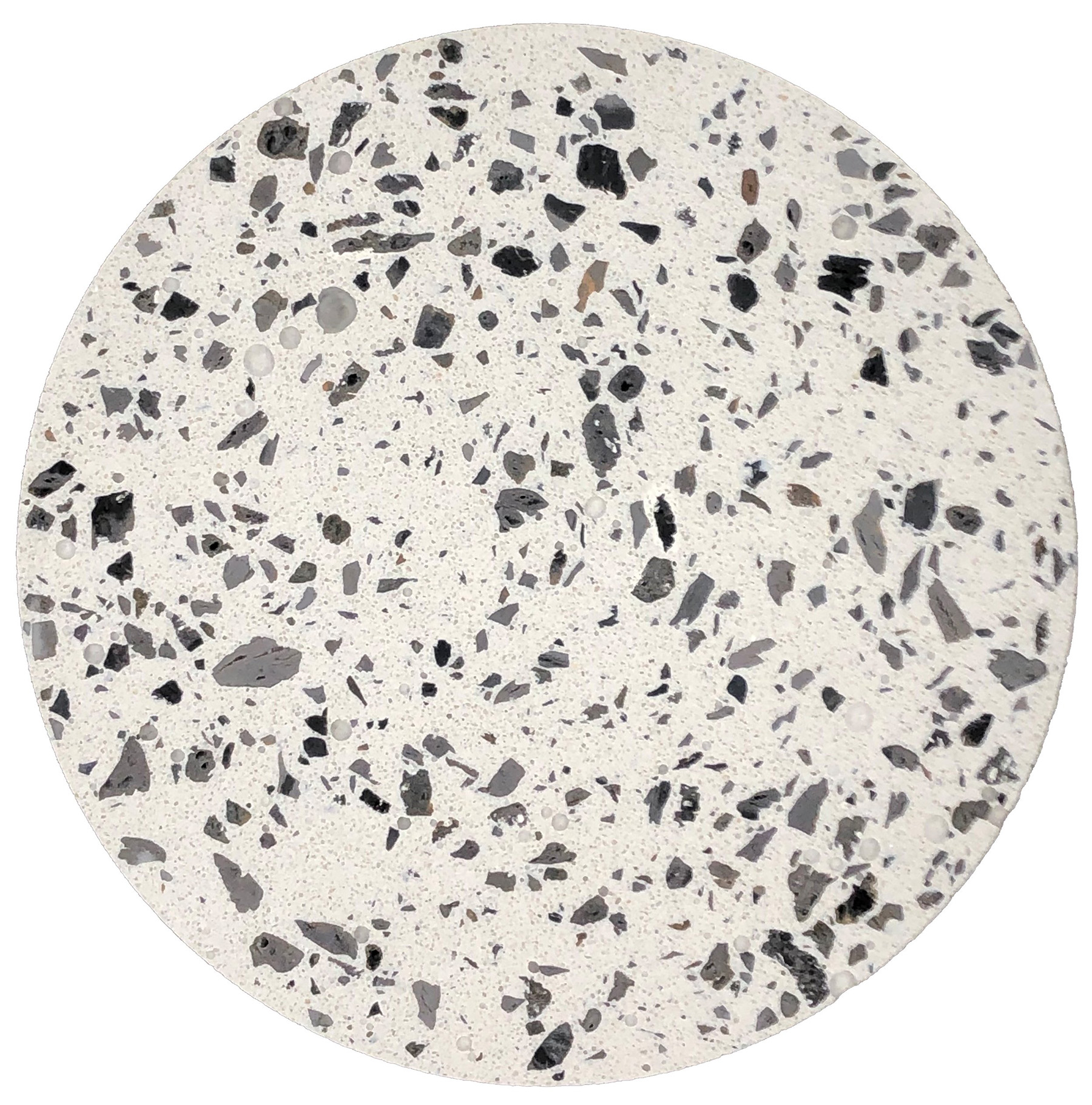
Internally Curing Concrete Produces EPIC2 Results
A proven but underutilized technology known as internal curing is garnering the attention of many States because it can increase the service life of concrete bridge decks by 25 to 50 years. Internal curing helps prevent cracks that occur as concrete shrinks. The cracks can be detrimental because they provide a direct path for chlorides to reach embedded steel reinforcement in the bridge, which leads to corrosion.
“Internal curing was explicitly designed to solve early-age cracking issues that are inherent to higher-performance concretes,” said Tim Barrett, co-leader of the Federal Highway Administration Every Day Counts (EDC) enhancing performance with internally cured concrete (EPIC2) team. “It’s a fairly easy technology to implement.”

The above graphic compares traditional curing, represented in the top two squares, to internal curing in the early stages (bottom left) and the simulated distribution of internal curing water (bottom right).
Credit: FHWAUnlike conventional curing, where water is supplied on the concrete’s surface, internal curing provides a source of moisture from inside the concrete mixture, improving its resistance to cracking and overall durability. To create internal curing, a portion of the fine aggregate is replaced with pre-wetted lightweight aggregates. “As the concrete dries, it creates empty pores, which automatically creates pressure that pulls water out of the aggregates and into the empty pores,” said Barrett.
Bridges are structurally engineered with a 75-year design life, and signature structures (bridges for which additional effort and cost for extended service life are warranted) frequently have design lives far greater than 100 years. Unfortunately, bridge decks deteriorate faster than any other bridge component due to exposure to various extreme conditions. This results in an average service life in the range of 25 to 50 years. “We are making bridges that require more than one bridge deck from the start, but we don’t need to limit ourselves to that because we have technology that allows us to make higher-performance concrete that can be designed upfront to make 75-year bridges a reality,” said Barrett.
Internal curing is not limited to use in bridge decks. It is appropriate for any concrete application that could benefit from reduced shrinkage or cracking potential. For example, repair materials that need to gain strength rapidly often contain a high amount of cement, which inherently creates shrinkage. Concrete pavements with internal curing have narrower cracks that are spaced farther apart and the pavement experiences less curling.
Extensive studies over the last 30 years show that internal curing addresses the root cause of self-drying shrinkage, but EDC is the first national, coordinated effort to educate stakeholders about its benefits. Three States have adopted the innovation as standard practice and use it regularly on projects. Four States and Federal Lands Highway are assessing internal curing and adjusting processes for full deployment. An additional 14 States plan to pilot the technology for the first time in the next 2 years. “The studies show that it works, and the States that have adopted it are getting extraordinary results,” said Barrett.

The dark aggregates in this cross section of a standard 4-inch-diameter cylinder are fine lightweight aggregates that are typically used for internally curing any concrete mixture.
Credit: FHWACase Studies
The New York State Department of Transportation (NYSDOT) began using internally cured concrete 15 years ago and now uses it on all multi-span bridge decks as part of NYSDOT Standard Specifications. Starting in 2008, NYSDOT began piloting internal curing on 20 bridges. In 2015, the agency conducted a performance review and found the bridges showed a 70-percent reduction in cracking compared to those that did not employ internal curing.
In 2015, the Louisiana Transportation Research Center (LTRC) completed two pilot projects using internally cured concrete. Each project included internally cured trial sections and control sections with conventional concrete. After nearly 2 years, LRTC leaders said the reduction in cracking in the internally cured concrete bridge sections was evident. The Lafayette Consolidated Government was so impressed by the pilot project results that it began requiring internally cured concrete for bridge deck construction in late 2016.
Some of the first internally cured concrete pavements in the United States were constructed in the Dallas/Fort Worth, TX, area beginning in 2005. These included a continuously reinforced concrete pavement freeway. Crack surveys were performed on a 430-foot test section of the highway 76 days after construction. The internally cured section had developed fewer shrinkage cracks at an average spacing of 31 feet between cracks—much larger than the typical 3- to 6-feet spacing of cracks on regular concrete. Researchers estimated that internal curing reduced maintenance costs by 15 percent.
Cost Analysis
Internal curing hides water inside a manufactured aggregate that expands with heat and creates extra porosity. This aggregate often has to be shipped, so in new applications there is an estimated potential 20 percent initial concrete material cost increase for internal curing or, when rolled into the project’s entire cost, a 2- to 5-percent increase overall. However, NYSDOT evaluated costs over the past 10 years and could not find any cost difference for the past 2 years because the market in New York is fully developed. The primary payoff benefit is found in the lifecycle cost assessment. “We’ve seen numerous studies that looked at life cycle costs,” said Barrett. “They estimate a 30- to 70-percent cost reduction over the structure’s life due to internal curing technology.”
—MORE INFORMATION
Visit the FHWA EPIC2 webpage.
Read the Internally Cured Concrete tech brief.
Subscribe to the EPIC2 e-bulletin.
Watch the FHWA Concrete Clips: Internal Curing video.
Contact Tim Barrett of FHWA’s Turner-Fairbank Highway Reach Center or Mike Praul of FHWA’s Office of Infrastructure.
Disclaimer: The U.S. Government does not endorse products or manufacturers. Trademarks or manufacturers’ names appear in this document only because they are considered essential to the objective of the document. They are included for informational purposes only and are not intended to reflect a preference, approval, or endorsement of any one product or entity.
Except for the statutes and regulations cited, the contents of this document do not have the force and effect of law and are not meant to bind the States or the public in any way. This document is intended only to provide information regarding existing requirements under the law or agency policies.
Recommended Citation: U.S. Department of Transportation, Federal Highway Administration - Washington, DC (2023) Innovator Newsletter, September/October 2023, Volume 17 (98). https://doi.org/10.21949/1521759



